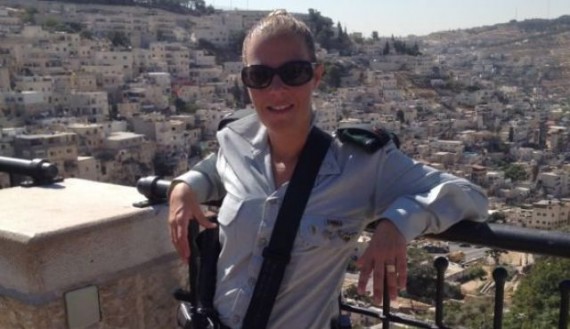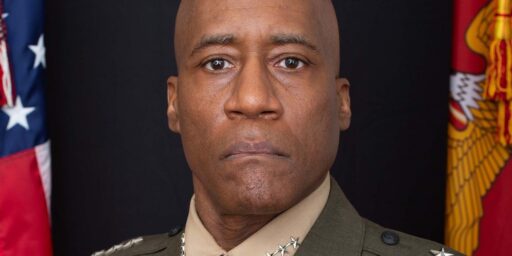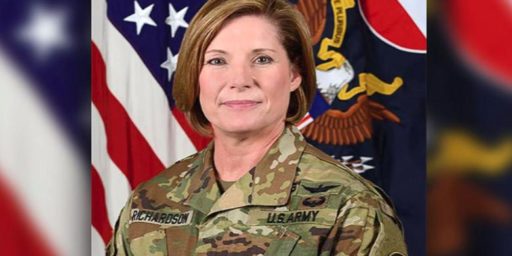Israel Appoints First Female Battalion Commander [UPDATED]
The IDF has finally put a woman in command of a battalion. They're decades behind American forces.
The Israeli Defense Force has for decades been cited as the model for integrating women into combat roles. Yet they have only just now appointed a female battalion commander.
Jerusalem Post (“IDF appoints first female battalion commander“):
The IDF has appointed its first female battalion commander, Maj. Oshrat Bachar, who will head a Combat Intelligence unit in the Southern Command along the border with Egypt.
Maj. Bachar will be promoted to the rank of Lieut.-Col, and will take charge of a battalion named Eitam, tasked with monitoring hostile terrorist activity in the Sinai Peninsula. She began her military career as a lookout soldier in the Combat Intelligence Corps, and went on to become a company commander in the field. From there, she became an instructor at the IDFs Combat Intelligence School, before serving as a department head in the office of the advisor on to the chief of staff on womens’ affairs.
Maj. Bachar is currently completing a course on command and special staff at Glilot, and will then go on to begin a battalion commander’s couse.
It’s stunning to me that it’s taken them this long to appoint a woman to command a battalion. Not an infantry battalion, mind you—a battalion, period.
To put it into perspective, as I’ve chronicled here over the years, the United States military has had three female four-star generals or admirals. Michelle Howard became the Navy’s first female four-star admiral last month and will be the second ranking admiral in the entire fleet. The Army blazed the train here, making Ann Dunwoody the first female four-star in US history back in June 2008—three years after she became the Army’s first woman three-star. Janet Wolfenbarger became the Air Force’s first four-star last June.
We’ve had female generals and admirals now for over four decades:
Anna Mae Hays, Chief of the Army Nurse Corps, became a brigadier general on June 11, 1970. Minutes later, Elizabeth P. Hoisington, Director of the Women’s Army Corps, received her shoulder stars. In 1971, the Air Force promoted the director of Air Force women, Jeanne M. Holm, to brigadier general. A few months later, Ann E. Hoefly, the Chief of the Air Force Nurse Corps, became the fourth woman general. In 1972, Alene B. Duerk, Chief of the Navy Nurse Corps, received a spot promotion to become the first female rear admiral (lower half), the Navy’s equivalent to brigadier general. The Navy promoted a female line officer, Fran McKee, to flag rank in 1976. RADM McKee thus became the first Navy woman who was not a nurse to achieve star rank. Two years later in 1978, the Marine Corps promoted its Director of Information and former Director of Women Marines, Margaret Brewer, to brigadier general. Director of Information and Technology, Chief Information Officer Vivien Crae was promoted to rear admiral by the Coast Guard in 2000.
While our military put women into separate sub-branches until they were fully integrated into the regular forces in 1978, we had women commanding battalions before Israel’s existence as a state. LTC Mary A. Hallaren commanded the 1st WAC Separate Battalion when it deployed to England for service in World War II in July 1943. I can’t offhand figure out who was the first woman to command a gender integrated battalion, but there were likely many of them upon full integration in 1978.
UPDATE: A Haaretz version of the story reports Bachar will be the first combat-battalion commander and reports:
Women have served in the past as battalion commanders in the education corps and in logistics units, but not in combat units. Around two years ago, a female officer was appointed commander of the communications battalion in the Intelligence Corps’ unit 8200. In the Israel Air Force, a woman has achieved the position of deputy squadron leader.
According to IDF figures, only 5 percent of senior commanders – colonel and above – are women, while 13 percent of lieutenant colonels are female.
That makes a lot more sense. I’m not sure what constitutes a “combat” battalion, in that the US armed forces classifies intelligence as a combat support, not a combat arms, branch.






